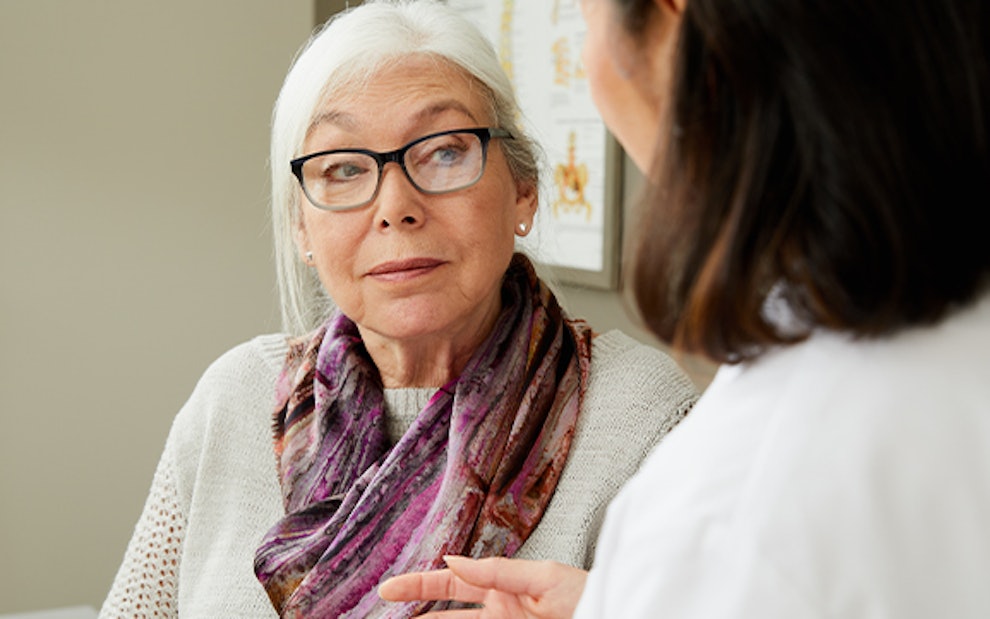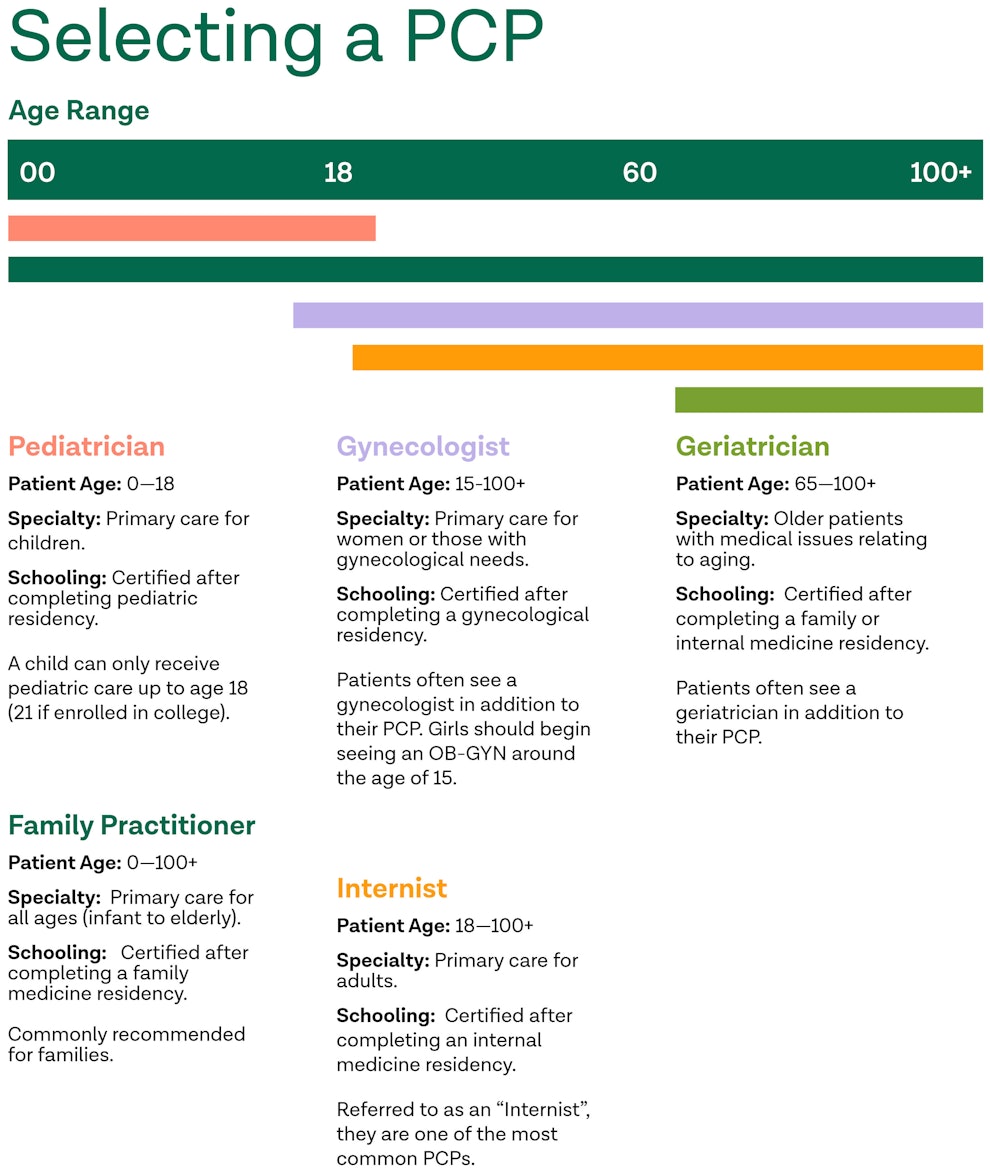13 tips on how to choose a primary care physician (plus 7 types of doctors to know about)
Article at a glance
- There are seven different types of doctors that have the ability to deliver primary care procedures such as internists, geriatricians, nurse practitioners, and more.
- Health insurance providers often compile a list of eligible PCPs and practices that are included in their member’s plans. This is important to consider because choosing a primary care physician that is out-of-network can be expensive and inconvenient. Read on to learn about these doctors and the health concerns they specialize in.
- There are a number of different factors to consider when searching for a primary care physician, such as location, eligibility, personal care needs, and more.

The U.S. Department of Health Resources and Services Administration (HRSA) predicts that by the end of 2020, there will be 220,800 primary care physicians providing care. This means, for patients, choosing a new primary care physician presents a number of options to choose from, leading to a variety of steps a patient can take to discover which physician and primary care practice is best for them.
Holistic health is the main goal of a primary care physician (PCP) as they organize and manage the care of their patients. Often, the are the pinpoint physician within their patient’s network of doctors and oversee their patient’s care plan to ensure they achieve optimal health. The following tips on how to choose a primary care physician will help patients find a doctor they trust.

Preparation
Tip #1: Make a list of the qualities you’re looking for in a doctor.
Prior to finding a primary care doctor, it’s good for a patient to set standards for the kind of care and health plan they’re expecting to receive. Think through questions/ideas such as:
- Any preference over seeing a male or female physician?
- The location of the practice and how long the drive would be.
- Are there any specific conditions the doctor should have experience with?
- What kind of care quality is the patient looking for?
- Does the practice have goals or standards they are working toward or required to meet as a healthcare team?
It’s also essential for a patient to consider their age-range, gender, and whether or not they have a family they want to include in their care. Some doctors specialize in care for specific age groups or genders, so it’s beneficial to keep that into consideration.

Tip #2: Know who provides primary care.
There are a variety of providers that treat patients and practice primary care, with each specializing in different kinds of care but all having the sole goal of facilitating a relationship with the patient. The sentiment behind this is that as the PCP and their care team get to know a patient and their medical history, the more thorough the care becomes. The most common PCP specialties to choose from are family practitioners, pediatricians, geriatricians, internists, and gynecologists.
- Family Practitioner: A ‘family physician’ or ‘family doctor’ is certified to care for people of all ages (infant to elderly). Due to their versatility, family practice physicians are commonly recommended for families. Prior to becoming certified, a family medicine doctor completes a family practice residency and goes through proceedings to become board-eligible.
- Internist: Internal medicine physicians are one of the most common primary care physicians. They are doctors that specialize in internal medicine and is known as an ‘internist’ or an ‘internal medicine physician.’ After completing a residency in internal medicine and becoming board-eligible, internal medicine doctors are certified to care for adults at any age.
- Geriatrician: A geriatrician specializes in providing aid to elderly patients who may be experiencing medical issues related to aging. According to the American Geriatrics Society, about 30% of people over 65 need geriatric care, and according to the American Association of Retired Persons(AARP), it’s common for a patient to see a geriatric doctor in addition to their PCP. Geriatric doctors become certified after completing a residency in family medicine or internal medicine and becoming board-eligible. For more information on geriatric care, visit this resource.
- Pediatrician: A pediatric doctor is certified to provide primary care services to children from their birth into adulthood. However, once a child becomes a legal adult at 18, they can no longer receive care within pediatrics; instead, they must switch to another PCP such as an internist or family physician. Depending on the primary care practice, a child who is enrolled in college may be able to see their pediatrician up until the age of 21. Pediatric doctors become certified after completing a pediatric residency and becoming board-eligible.
- Gynecologist: A gynecologist is a PCP that practices specialized care in gynecological medicine after completing a gynecological residency and becoming board-eligible. Gynecologists specialize in women’s health, meaning they provide specialty care to patients who are women, and often, a patient sees their OB-GYN in addition to their primary care doctor. The American College of Obstetricians and Gynecologists (ACOG) recommends that a girl should begin seeing an OB-GYN between the ages of 13 and 15.
Note: Primary care physicians are M.D.s (Doctor of Medicine), while others are D.O.s (Doctor of Osteopathic Medicine), Nurse Practitioners, or Physician Assistants. Although D.O.s undergo extra training on specialized knowledge of the body’s structural or musculoskeletal system (nerves, muscles, and bones), it is commonly noted that “In modern healthcare, there isn’t much practical difference between a D.O. and an M.D.” For more information on the differences between an M.D. and a D.O., visit this resource. These providers are commonly known for providing patients with routine check-ups and keeping up to date with preventive care procedures such as shots, vaccine boosters, etc. For a comprehensive list of what check-ups are required based on a patient’s age range and gender, visit this resource.

Finding a Doctor
Tip #3: Check with your health insurance provider.
It’s important for a patient to check their health insurance plan to see what PCPs are covered prior to making an appointment. Most times, insurance providers already have a composed list of potential primary care doctors in the area that their members can choose from.
The two most common insurance plans are Health Maintenance Organization (HMO) plans and Preferred Provider Organization (PPO) plans. An HMO insurance plan requires that its members have a primary care provider to manage their care, but since they are connected to a network of service providers, only select PCPs are available for members to choose from. HMO plans also require that their members remain in-network for care unless they receive a referral from their PCP or have an emergency situation. It’s not necessary for a member to have a PCP with a PPO insurance plan, but if they choose to have one, it’s less expensive to choose a provider that’s in the plan’s network vice an out-of-network provider. Medicare and Medicare Advantage plans that are available for most Americans ages 65 and older and operate in the same way as general HMO and PPO plans. Medicare HMO plans require a primary care provider, while Medicare PPO plans do not.
Don’t hesitate to reach out to an insurance provider directly via email or telephone to inquire more about which PCPs and practices are covered by their plan.
Tip #4: Gather information from healthcare databases.
There are a plethora of healthcare databases available such as the American Medical Association’s Doctor Finder website, the list of directories from MedlinePlus, and the Medicare Physician Compare tool for patients who have Medicare insurance plans. While these websites and databases may not provide specific, individual doctors, they narrow down the search and compile a list of primary care providers in a patient’s community.

Tip #5: Ask family and friends for recommendations.
There is no better recommendation than one that’s word-of-mouth. When searching for a new PCP, ask family and friends if they recommend anyone in the area or how they went about finding their doctor. Ask them about their experiences, positive and negative, with certain doctors found during research to gather personalized information on the doctor’s background prior to making an appointment.

Tip #6: Compile a list of potential doctors.
Writing down a list of potential doctors, where their practices are located, and what they specialize in will help a lot when trying to narrow down which PCP will be the best fit. It allows the patient to come back to a comprehensive page of research where they can compare and analyze each doctor.
Tips for narrowing down your list of potential doctors:
Once a patient has found a few potential doctors, it’s important to investigate them and narrow down the list to one healthcare provider who appears to be the best fit.
Choosing a Doctor
Tip #7: Call their office.
Many say that the best way to get to know a doctor’s practice is by calling their office and hearing how their staff treats potential new patients. For example, if their team is abrupt and impatient, their practice may not be the best to visit. While on the phone, it’s good for a patient to ask questions about their potential doctor and what their availability is like so they can gauge the doctor’s background and how the patient will fit in with their practice.
Tip #8: Check to ensure the PCP is board certified.
Doctors who are board-certified have completed extra training after medical school and passed an exam that qualifies their expertise in certain specialty areas of care such as internal medicine, family medicine, geriatrics, gynecology, and orthopedics. Discover if a potential primary care provider is certified by visiting this source that the American Board of Medical Specialties maintains.

Tip #9: Track your route to their practice.
An important factor for patients to consider is the location of their potential doctor’s office. How far is it from home? Is it in a rural or metropolitan area? These questions come into play once the patient has to drive and see the doctor. For example, if a potential doctor is an hour away from home, that’s going to be a hefty commute to make just for a patient to receive their annual physical. Plug the address of the primary care practice into a GPS to map out how long it takes to commute there from home.
Some primary care practices include transportation for their patients as a benefit. Be sure to contact the health provider directly to inquire about their aid with transportation and how their transit system works.
Tip #10: Ask questions that pertain to your desired care.
Refer back to the list discussed in Tip #1. By performing prospective research, asking family or friends, and having discussions with the office staff about potential PCPs, a patient can ensure that a new primary care physician meets their quality standards. Think through questions like:
- If you speak a different language, it might be important to ask for a doctor that speaks the same language or for a translator to be provided.
- Is there a chronic medical problem you are struggling with? Would you prefer a doctor who has prior experience treating this chronic illness or condition?
- If your primary care doctor is not available, who will you meet with to discuss your care if necessary?
- Is medical care provided on weekend or evening hours if needed at this practice?
Tip #11: Research patient forums.
An excellent way to tell if a primary care provider is highly rated is by reading the reviews made by other patients. Check review pages and forums to see other people’s ideas on how a particular doctor, medical group, or practice treats their patients. This is also a great way to get insight into how others have chosen their PCP in the past and what their experience with having a PCP has been like.

Tip #12: Choose a doctor and set-up an initial appointment.
There’s no better way to get to know someone than by meeting them in person. Schedule an appointment with the doctor that appears to be the best fit to get a feel for their personality and health care goals. Be sure to ask the practice about their doctors and what they specialize in, in order to decide which would be the best match. Meeting a doctor in person is perfect for getting an overall idea of who they are, why they’re in the healthcare industry, and how they handle their patient care.
The First Appointment
Tip #13: First impressions matter: Evaluate your provider’s quality of care.
When first meeting a provider, it’s crucial for a patient to note how they feel when leaving the appointment. When talking to the doctor, ask them questions that point towards their quality of care and desire to be in the healthcare field. When talking to them, pay attention to their ability to listen, body language, and other cues to see their approach to patient care. If a provider is rushed, attempting to cut off the question, or speaks in a negative tone, this could demonstrate that the provider is more goal-oriented towards completing their job than wholly caring for the patient’s problems, concerns, and desires.
Good questions to ask:
- Why did you decide to become a PCP?
- What interests you most about being in the healthcare field?
- Does your practice have a code of ethics or individual goals they wish to fulfill as a team of providers?
- What are your personal goals as a primary care physician?
In order for a patient to find the right doctor for them, if there are lingering doubts or hesitancies after an initial appointment, it’s important for the patient to leave feedback with the practice and inquire about other doctors they can schedule for their next appointment.
Sources
- https://www.nia.nih.gov/health/how-choose-doctor-you-can-talk
- https://health.gov/myhealthfinder/topics/doctor-visits/regular-checkups/choosing-doctor-quick-tips
- https://www.certificationmatters.org/
- http://www.medicare.gov/physiciancompare
- https://www.medlineplus.gov/directories.html
- https://doctorfinder.ama-assn.org/doctorfinder/disclaimer.jsp
- https://kidshealth.org/en/parents/first-gyn-exam.html
- https://www.aarp.org/health/conditions-treatments/info-2019/geriatrics-specialist.html
- https://www.aafp.org/about/policies/all/primary-care.html
- https://kidshealth.org/en/parents/primary-care-physician.html
- https://medlineplus.gov/ency/article/001939.htm
- https://kidshealth.org/en/parents/nurse-practitioner.html
- https://kidshealth.org/en/parents/adult-care.html
- https://www.keckmedicine.org/what-your-primary-care-doctor-is-looking-for-in-your-30s/
- https://kidshealth.org/en/parents/first-gyn-exam.htm
- https://wa.kaiserpermanente.org/html/public/health-wellness/tests/recommendedTests/adultTests
- https://patient.info/forums
- https://www.graybill.org/patients-and-visitors/choosing-right-doctor/
- https://www.piedmont.org/living-better/your-doctor-the-difference-between-an-md-and-do
Choosing a PCP
This infographic shares tips on the best way to choose a primary care physician.



